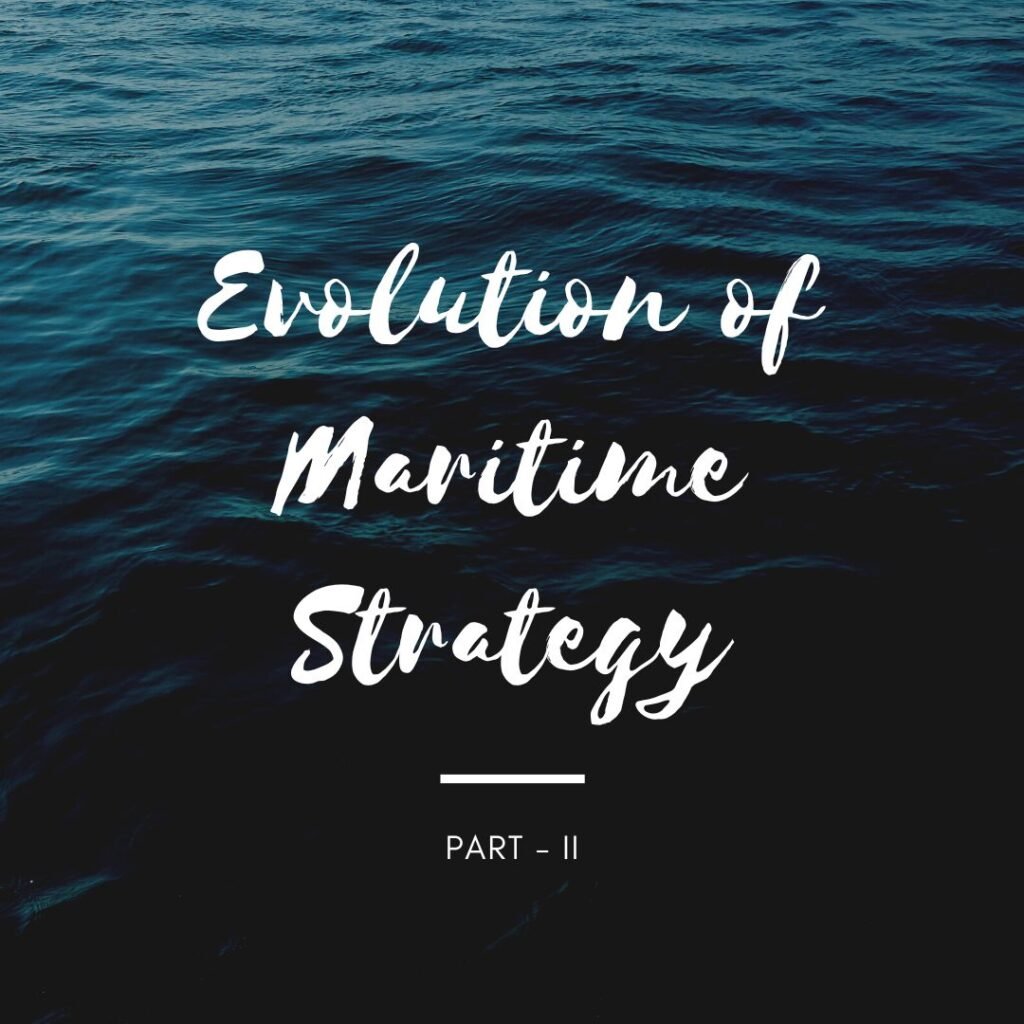Evolution of Naval Thought In India: Indian Diplomat and Professor K.M.Panikkar, highlighting the significance of the Indian Ocean for trade and security of India in his works published in 1944-45 wrote, “India never lost her independence, till she lost the command of the sea in the first decade of 16th century” and for the security of India, “Indian Ocean must remain truly Indian”. Perhaps overemphasizing the Indian role without taking into account Indian Navy’s wherewithal more than 70 years ago, however, steadily and gradually Indian Navy’s ambitions are on that path.
Nevertheless, one needs to understand that geography is a vital aspect, which can aid but also complicate maritime security, depending on the nation’s geographic characteristics and the prevailing geo-strategic environment. India has a vast coastline extending to more than 7,500 km, with more than 1,200 islands, and a large Exclusive Economic Zone (EEZ) of about two million sq. km. The anticipated addition of approximately 1.2 million sq. km of continental shelf would make India’s total seabed area almost equal to the Indian land mass.
The Beginnings
During the process of partition, Commodore James Jefford, a senior Royal Indian Navy officer, led a subcommittee of British, Hindu and Muslim officers charged with dividing up naval material among the two countries. Once negotiators decided on a proportion of two to one, allocation of ships between the new navies was relatively easy. As the bigger country, India received four sloops, two frigates, 12 fleet minesweepers, one corvette, one survey ship, four armed trawlers, four motor minesweepers, one motor launch, four harbor defense boats and all landing craft.
Pakistan in turn gained two sloops, two frigates, four fleet minesweepers, two armed trawlers, two motor minesweepers and four harbor defense boats. The major plans for expansion of the two navies following partition showed a fleet of aircraft carriers and cruisers for India and squadron of cruisers and fleet destroyers for Pakistan. These divisions shed some light into the natural progression of the Indian Navy.
Naval Plans
After Independence, the first Indian Naval Plan papers envisaged the role of Navy to ‘safeguard her shipping on the high seas from interference in war; to ensure that supplies can both reach and leave India by sea in all circumstances; to keep open her ports and coastal shipping routes; to prevent any enemy landing on her shores; and to support the Army in any operations which may be required in the furtherance of the national policy’.
That is to say protection of shipping and SLOCs, coastal defense and support of friendly forces on the ground; in essence a defensive strategy except ability to support army wherever required. First Indian Naval Plan papers with a suggested period of 10 years, included two light fleet carriers, three cruisers, eight destroyers, four submarines apart such smaller ships as were necessary for training and auxiliary purposes. However, due Indian continental mindset, these goals could not be achieved. Nevertheless, by 1961 India had acquired a number of major warships.
| Type | Number | Origin |
| Light Cruiser | 02 | Britain |
| Light Destroyers | 03 | Britain |
| Landing Ship Tank | 01 | Britain |
| Escort Destroyers | 03 | Britain |
| Light Tanker | 01 | Italy |
| Inshore Minesweepers | 02 | Britain |
| Coastal Minesweepers | 04 | Britain |
| Anti Aircraft Frigates | 03 | Britain |
| Surface Escorts | 02 | Britain |
| Anti Submarine Frigates | 03 | Britain |
| Light Aircraft Carrier | 01 | Britain |
War Periods
Majority of Indian Naval infrastructure remained on the western coast along Arabian Sea. However, post 1962 Sino-Indian war the recommendations were made that the Navy should have a fleet in both the Arabian Sea and Bay of Bengal with ‘a force level of 138 ships’. Indian Navy also ventured to acquire a robust Sea Denial capability through acquisition of submarines. The first four submarines were inducted into the Indian Navy from 1967 to 1969, bought from Russia. By 2 September 1965 one destroyer and four frigates were deployed in eastern seaboard.
INS Vikrant and Delhi were under repair at Bombay and majority of destroyers and frigates after exercising off Vishakhapatnam were stationed at Bombay. Aircraft from aircraft carrier INS Vikrant were deployed on 5 September in Bombay and Jamnagar. Preparations made were makeshift indicating lack of planning implying that Indian Navy was not ready for participation in a 1965 war.
The NHQ operations directive had stated that the aim was ‘the protection of own trade’, and that had been achieved. This contention was hotly debated subsequently and the demand for reform continued. These reforms saw Indian Navy performing much better in 1971 war against Pakistan, where IN maintained Sea Control specially in Bay of Bengal.
Overall, Indian Continental Mindset got rigid after wars with China and Pakistan. These issues hampered the basis of India’s Naval Plan papers and strategy till the end of the Cold War.
Post Cold War Era
The end of the Cold War followed by economic upswing, especially in India (which simultaneously undertook a liberalization of its economy) and China brought about a new focus on the Indian Ocean region as an arena featuring important Sea Lanes of Communication (SLOCs) and maritime trade protection, both related primarily to the flow of oil. The focus, therefore, changed to ensuring a secure maritime environment that emphasized control of SLOCs to ensure protection of maritime trade and shipping as well as for exploitation of maritime resources in the region.
For India, it also meant security of infrastructure and other assets in the maritime zones and the littoral related to the extraction, transportation and reception of domestic energy resources. Accordingly, Indian Navy’s first Strategic Defense Review in 1998, laid out four roles for Indian Navy; sea-based deterrence, economic and energy security, forward presence and naval diplomacy. The early 1990s also awakened the littorals’ nationalistic, economic and cultural thought processes that led to the advent of regional interactions like the South Asian Association for Regional Cooperation (SAARC) and Indian Ocean Rim-Association for Regional Cooperation (IOR-ARC).
Sea Dependence
Today India’s energy security has a vital role in national development, and is highly dependent on the seas. Nearly 80% of the India’s crude oil requirement is imported by sea, using the International Shipping Lanes (ISLs) across the Indian Ocean. Another 11% of national crude oil requirement is met from offshore energy sources within the Indian EEZ. Offshore gas fields also contribute to 80% of India’s domestic natural gas production.
In addition, India has built up substantial refining capacity and exports refined petroleum products to many other countries by sea. The products of the petroleum industry account for about 15% of GDP. Taking into account the total oil imports by sea, offshore oil production and petroleum exports, the India’s cumulative ‘sea dependence’ for oil is estimated to be about 93%. Approximately 56% of this oil flow comes from Gulf countries and passes through North Arabian Sea.
Merchandise trade constitutes 42% of India’s GDP, and is expected to increase in the future. More than 90% of India’s international trade by volume and over 70% by value is carried over the seas. The total size of the Indian shipping industry has been growing over the years and so is the dependence on international shipping as exports of goods and services from India are expected to increase from the current level of about 25% of GDP 38% in 2032. India also has 12 major and 200 minor ports, spread along its East and West coasts and islands.
India’s seaborne trade is projected to grow up to 2,134 million MT by 2025. With growing trade dependence, the infrastructure is bound to increase. For instance, according to the Indian Ministry of Shipping, the budget allocation for 2016–17 to be used for maintenance and expanding infrastructure surrounding ports that support the shipping industry was roughly $280 million. Similarly for FY 2020-21, in Indian Govt’s developmental plans for maritime sector named Sagarmala, 574 projects for port modernization, port connectivity, port-led industrialization, coastal shipping routes were included.
Maritime Doctrine
Indian Navy promulgated its first Indian Maritime Doctrine in 2004 and revised it in 2009, and the Freedom to Use the Seas: India’s Maritime Military Strategy, was published in 2007 and revised in 2015. These documents again laid out four roles for the Indian Navy; military, diplomatic, constabulary and benign. Interesting evolution is the sheer width of the gamut of potential military roles laid out for the Indian Navy, appear to encompass every possible wartime function.
Indian Navy has declared areas of primary and secondary interest. The primary areas of maritime interests involve India’s immediate coastal regions, the Arabian Sea, the Bay of Bengal, the Andaman Sea, the Arabian Gulf, the Gulfs of Oman and Aden, the Red Sea, critical chokepoints to include Hormuz and Malacca, and the related littorals. These areas may make some sense as they involve deterring imminent threat to Indian territory and protection of shipping areas that contain vital resources for India to import.
The secondary areas of focus demonstrate part of the reasoning for India’s push toward modernization, power projection, and expansion in the maritime arena. The Indian Navy includes the Southeast Indian Ocean, the South and East China Seas, the Western Pacific Ocean, the Mediterranean Sea, the West Coast of Africa, Antarctica, and the relating littorals as secondary areas of interest. These secondary areas require the assumption that India has national and strategic interests in these locations, requiring some sort of naval presence.
In addition, what was defined as naval diplomacy in 1998 has been split into two different roles; benign and diplomatic. Through its multiple and increasingly institutionalized naval exercises with both regional and extra-regional navies, and its hosting of multilateral initiatives such as the Indian Ocean Naval Symposium, the Indian Navy clearly sees a comparative advantage for their service as a diplomatic instrument for New Delhi.
Net Security
The Indian Navy asserts that there will be a “steady increase in the Indian Navy’s operational footprint across India’s areas of maritime interest, with a growing cooperative framework and contributions as a ‘net security provider’ in the maritime neighborhood”. The phrase ‘net security provider’ is what stands out the most in India’s maritime strategy.
This suggests that India is preparing to take on the role of guarantor for maritime security in the IOR, a role that has since transferred from the United Kingdom following partition to the United States. To cater for the China dilemma, Indian Navy has increasingly embarked on cooperative mechanisms such as exercises and deployments as part of QUAD as well as regional security mechanisms such as Coordinated Patrols (CORPATs) in Bay of Bengal and Malacca Coordinated Patrol (MCP) in Strait of Malacca.
Today, the development of India’s modernized naval force demonstrates a transitional effort in that direction of first responder in IOR. Although, in the words of some Indian Navy officers “Cinderella Service” has been neglected in the past, however, continuous increase in budget share is indicative of Indian Government’s inclination towards maritime sector, especially as an arena of enhanced cooperation with US as a strategic partner.
Indian Navy development budget is steadily being enhanced, greater than Indian Army. US on the other hand also wishes to see the enhanced role of Indian Navy in Indo-Pacific region for its long term goal of containment of China. A role brought out by Chuck Hagel in his speech at the Shangri-La Dialogue 2013 wherein he said:
“India’s role as a stabilizing power is of growing importance with the increase of trade and transit between the Indian and Pacific Oceans. The United States considers India’s efforts to enhance its military capabilities as a welcome contribution to security in the region”.
Nuclear Deterrent
Another, shift in Indian Maritime strategy is to seek greater autonomy by becoming the core element in India’s second-strike nuclear deterrent. Citing three principles of India’s nuclear deterrence, i.e. credibility, effectiveness and survivability, Indian Navy asserts that these are imbibed in the sea-based segment of the nuclear triad, primarily the nuclear powered submarine carrying ballistic missiles (SSBN).
SSBN, due to stealth characteristics enabling discrete and prolonged deployment, and combat capabilities including weapon outfit, provides a credible, effective and survivable capability and contributes to assurance of punitive retaliation. SSBN deployments also counter an adversary’s strategy of seeking advantage from nuclear posturing or escalation.
INS Arihant is the first in its class of indigenously built nuclear-powered ballistic missile submarines. Originally chartered as the Advanced Technology Vessel, the Arihant-class is designed to carry the K-15 Sagarika nuclear SLBM as part of India’s nuclear triad. This presents a major step forward in strategic distribution among India’s military services as they did not possess a sea-based deterrence capability. Additionally, it is confirmed that further development into the K-4 SLBM, possessing nearly five times the range of the K-15, was successfully test-fired from the Arihant in early 2017.
Proactive Strategy
Lastly the most important shift in Indian deployment patterns to support the PAOs strategy is her Mission Based Deployments (MBDs). Same are manifested in its maritime security strategy document promulgated in 2015, wherein, the key actions for net maritime security under this strategy are Presence and Rapid Response, Capacity Building and Capability Enhancement and Development of Regional MDA.
This battlefield transparency will further enhance through agreements such as BECA and COMCASA etc. Indian Navy seeks to achieve these through Presence and Surveillance Mission (PSM), Patrol and Overseas Deployments.
Navalism in IOR is already on the rise. Indian Navy is likely to continue to make her presence felt throughout the region. Its growth is not merely a necessity, it is a compulsion.
Note: This article contains 31 references. For academic use please consult Stratanal.com through email.
About the author.






